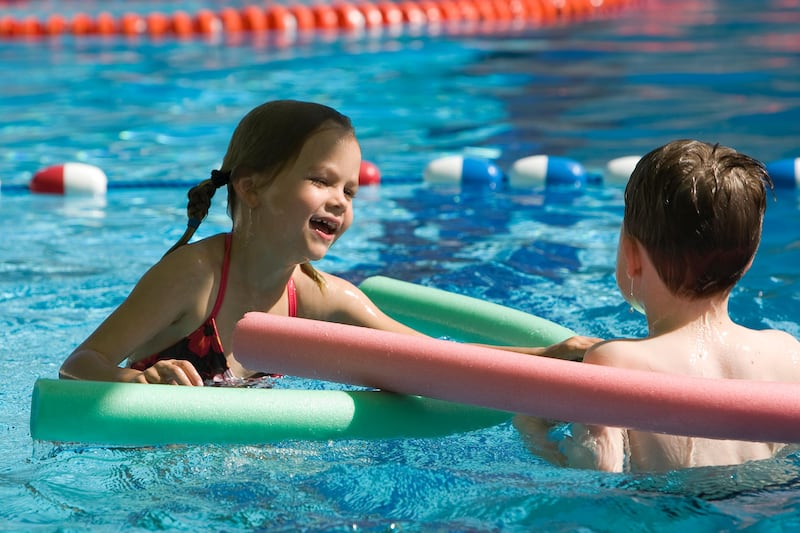Parents could be unknowingly applying “toxic” sunscreen to children playing in swimming pools after research discovered a harmful chemical reaction between popular UV filters and chlorine.
Scientists from the Faculty of Chemistry of the Lomonosov Moscow State University found some sunscreens react with chlorinated water and ultraviolet radiation to give off toxic chemicals.
Doctors are advising young children are covered up when outdoors in the sun, rather than use potentially harmful products containing avobenzone – a common sunblocker used in many sunscreen products.
“We know for certain that sun exposure is linked to skin cancers and that sunscreens can help reduce the risks,” said Dr Hinah Altaf, a dermatologist at Canadian Specialist Hospital, Dubai.
“A study indicating production of harmful compounds when avobenzone comes in contact with chlorinated water should not be ignored.
“We need to be watchful and use alternatives to avobenzone as sunscreen while swimming - but there is no evidence that we need to avoid sunscreens altogether.”
In tests, avobenzone was found to provoke dysfunction of the liver and kidneys, along with nervous system disorders when mixed with chlorinated water.
Avobenzone is the most popular ultraviolet light filter in the world. Its ability to absorb harmful UV rays has seen it widely used in other cosmetics like face creams and lipsticks.
However, doctors have urged caution over the research, claiming that a randomised controlled trial is the gold standard on which clinical advice should be offered and this was not part of the study.
Medical professionals have also said people should take other precautions to avoid sunburn, as the cancer risk outweighs the potential for toxic sunscreens.
___________________
Read more:
[ Mothers find choosing sunscreen a conundrum ]
[ Call for awareness of vitamin D deficiency ]
[ Do sunscreens do more harm than good? ]
___________________
Although safe, Russian scientists proved that in water solution, avobenzone is capable of breaking down into hazardous chemical compounds.
Their experiments simulated a real situation where sunscreen is applied to the skin of swimmers, and concluded that the breakdown of avobenzone may take place on wet human skin.
The chemists found avobenzone breaks down in the water, forming organic compounds belonging to the classes of aromatic acids more commonly found in toxic products such as tear gas.
One of the project’s authors, Albert Lebedev, said more research into how popular cosmetics transform with other chemicals is important to offer up-to-date consumer advice.
Researchers also found a reaction with water and copper salts, which are often added to pools to produce a blue tint. The reaction formed bromoform, known to damage the liver and kidneys.
Dr Altaf advised against the use of some sunscreens, and particular care with those offering day-long protection.
“Once-a-day sunscreens should not be promoted,” she added. “They provide a false sense of protection, especially during extended sun exposure, sweating and swimming.
“The minimum sunscreen that offers about 93 per cent protection from UVB is SPF 15.
“Children are more sensitive to the harmful effects of sun so sun protection measures should be incorporated in the routine early in life so that it becomes a habit.”
In a report on sunscreen delivered by US researchers at the Environmental Working Group, it was noted a form of vitamin A added to sun protection creams to help prevent ageing could actually speed up the development of some cancers.
The EWG said sunscreens containing retinyl palmitate could hasten the development of skin lesions and tumours if applied in direct sunlight, following experiments conducted on hairless mice exposed to UV light every day for a year.
Dr Bana Haithum Lufty, a GP at the dermatology department at Al Sarq Hospital, Fujairah, encouraged people to look at a sunscreen’s ingredients before applying it to skin.
“Two of the chemicals produced in this research — acetyl benzenes and phenols — are particularly toxic,” she said.
“Simply staying in the shade is one of the best ways to limit your UV exposure.
“We generally recommend sunscreen is reapplied liberally every couple of hours to ensure exposed patches are protected.”
Parents are advised to keep children aged under six months out of direct strong sunlight, and to cover up with suitable clothing as their skin is more sensitive than adults.
Families should also avoid the hottest part of the day, between 11am and 3pm and cover children in a sunscreen with a sun protection factor of at least 30.
“Parents should take extra care to protect babies and children,” Dr Lufty added.
“Their skin is much more sensitive than adult skin, and damage caused by repeated exposure to sunlight could lead to skin cancer developing in later life.”
Findings from the Environmental Working Group’s 2017 sunscreen report:
Forty-six products marketed to children earn an EWG sunscreen rating of 7 to 10, which are the lowest scores for products in the EWG Sunscreen Guide, as 1 is the best.
Twelve of these sunscreens for kids and babies contain oxybenzone, which can act like estrogen in the body, retinyl palmitate and SPFs above 50+, which tackle UVB but not UBA rays.
Five were aerosol sprays that don’t provide a thick, even coating on skin and that can expose sensitive young lungs to potentially hazardous chemicals.
Two products score 10 because, in addition to other formulation concerns, the labeled SPF is very different than EWG’s estimated value.
Full details of the report can be found at ewg.org.







